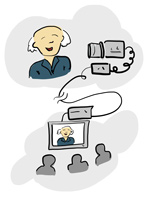Pattern: Live Streaming

Context/Setting
A course scheduled to take place across multiple locations.
Problem
Not all participants or instructors can visit a given location, as travel is not possible for various reasons. Consequently, valuable contributions from experts are missing from the event, or students miss out on the content discussed in the session.
Tension
Practical relevance of university teaching, attendance requirements
Solution
Synchronous video and audio transmission (live streaming) allows for communication that closely resembles in-person interaction, independent of location. Real-time transmission can foster natural conversation. The stream can be enriched with chat, screen sharing, and other tools.
Details
Live streaming can occur in various configurations:
- One-to-one: Two rooms are connected via an AV live stream, or an expert is brought into the event through live streaming. Communication typically includes a bidirectional AV channel.
- One-to-many: A live stream from an event room is viewed by participants from different locations. Both unidirectional and bidirectional scenarios are common, with return channels often provided via chat to avoid interrupting the presentation.
- Many-to-many: Participants and instructors meet in an online room with everyone joining from different locations. Often, return channels are available, but for participants, they may be limited to chat or audio.
Pitfalls
The media competency of participants is crucial for smooth proceedings. Initial sessions are often accompanied by eLearning or media experts. Test runs can help identify and resolve technical issues early on.
Live streaming requires participants to adhere to scheduled times for events. However, recording options are generally offered.
Advantages
Expands the closed event space by allowing geographically distant experts or students to join. It also enables views into distant or less accessible spaces.
Disadvantages
Communication via a medium can initially feel unfamiliar. Technical issues may overshadow the actual content.
- Examples
The seminar "Rivalisierende Männlichkeiten" in the German Studies department was linked with two partner universities of UHH (Duke University/North Carolina and Humboldt University of Berlin). A series of videoconferences constituted a significant component of the setup phase, occurring weekly at the same time across all three seminar groups. Due to time constraints and technical requirements, these sessions followed a precise schedule. Students presented their short presentations to participants from all three seminars and subsequently discussed the findings together. This setup allowed for a completely different form of interaction compared to a single seminar. The seminar plans were intentionally designed to differ—for instance, different secondary literature was assigned—to make the large group discussions substantively rewarding. The eLearning office assisted the instructor with the seminar's technical and pedagogical planning and ensured smooth conference operations. - The "Software Development I+II" lectures in the Computer Science department have been broadcast live from the lecture hall to the internet since the winter semester 2012/13. Given that students have many classes and exercises on the Hamburg-Stellingen campus while the lecture takes place on the main campus, live streaming can reduce travel time and delays for students.
Tools
- Acrobat Connect (OLAT, DFN)
- Wirecast (Lecture2Go)
- Videoconferencing system
- Minicaster
Related Patterns
- Lecture Recording
